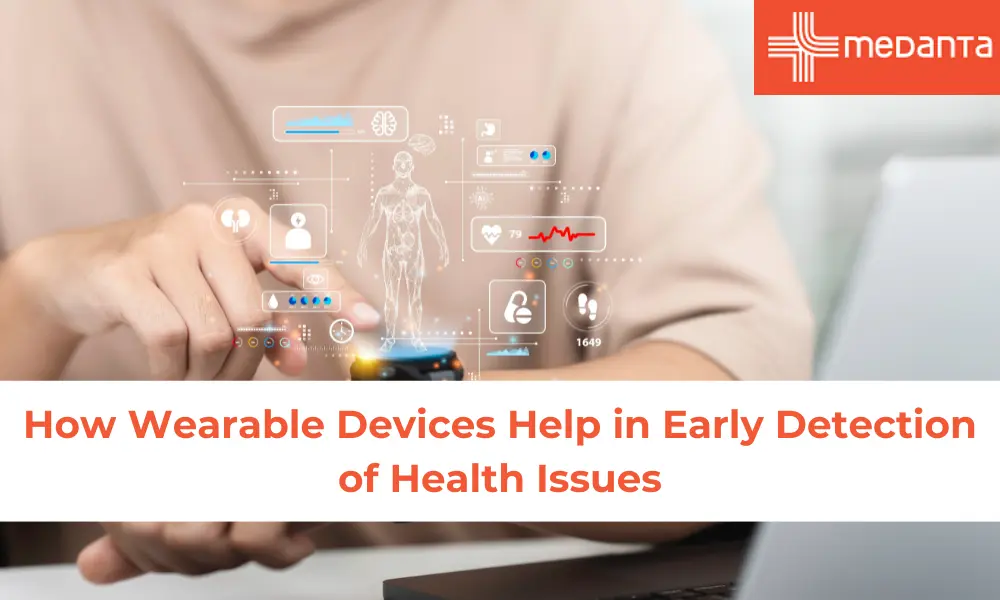How Wearable Devices Help in Early Detection of Health Issues

TABLE OF CONTENTS
- Key Health Metrics Monitored by Wearables
- Role of AI and Data Analytics in Early Detection
- Real-World Examples of Early Health Issue Detection
- Wearables in Chronic Disease Management
- Contribution to Preventive Healthcare
- Integration with Healthcare Providers and Systems
- Privacy and Data Security in Wearable Devices
- Limitations and Challenges of Wearable Tech
- Future Trends in Wearable Health Technology
- Conclusion
- FAQs
Wearable health technology continues to expand rapidly and modern wearables do much more than count steps or measure heart rate - they track vital health metrics like blood pressure, oxygen saturation and body temperature. These smart devices have captured everyone's attention in the last decade, particularly in healthcare, as they provide real time, non-invasive monitoring options for users.
These innovative gadgets revolutionise healthcare (they let you take charge of your health). What makes these tools truly powerful is their knack for detecting potential health issues early, often before symptoms become noticeable. In these smart wearables you will get sophisticated algorithms (trained on vast datasets) to detect early warning signs of various health conditions. They act as personal health guardians that continuously monitor vital bodily functions.
Key Health Metrics Monitored by Wearables
Smart wearable health devices do much more than count your steps. These gadgets track many vital signs to give you a detailed picture of your health.
Your heart health is a top priority. These devices track resting heart rate, which shows your cardiovascular health and fitness levels. They also measure heart rate variability (HRV) to show how well you bounce back from stress. The advanced models can perform electrocardiogram (ECG) tests that spot issues like atrial fibrillation.
Breathing health tracking plays a crucial role. The devices measure blood oxygen levels (SpO2), which should stay between 95% and 100%. Some models track your breathing rate, which usually ranges from 12 to 20 breaths per minute.
Sleep tracking has grown beyond just measuring how long you sleep. Today's technology breaks down your sleep into light, deep, and REM stages. This detailed breakdown helps boost your brain function and physical recovery.
These devices also watch for changes in your body temperature that might signal illness or hormonal shifts. If you have diabetes, continuous glucose monitors give you up-to-the-minute data about your blood sugar levels.
Physical measurements include VO2 Max, which shows how much oxygen you use during exercise—a vital sign of heart fitness. Activity tracking includes your steps, posture changes, and exercise intensity.
The best wearables combine all these measurements into detailed "readiness scores". With these you can balance activity and recovery.
Role of AI and Data Analytics in Early Detection
Smart AI systems power wearable health technology by making sense of your body's data. These clever algorithms work silently and detect health problems before symptoms become noticeable.
AI systems excel at processing vast data from wearable devices. They can spot patterns in your heart rhythm that might indicate atrial fibrillation. The technology becomes even more powerful through predictive analytics (AI and machine learning work together) to forecast potential health issues by detecting subtle changes in your body's signals.
Research has revealed remarkable results:
AI systems predict acute kidney injury 48 hours ahead with 90% accuracy in severe cases
Machine learning models detect seizures with 78.2% accuracy by analysing heart rate patterns
Fall detection systems using logistic regression achieve 100% accuracy when identifying dangerous falls
These smart systems do more than gather data. Advanced systems combine multiple data streams to create a detailed health snapshot that proves more valuable than individual measurements. This allows doctors to identify and treat developing health problems before they become serious.
Real-World Examples of Early Health Issue Detection
Real people's success stories show how valuable wearable health technology can be in everyday life. Sue VanWassenhove's story began after she had fallen several times. Her adult children gave her a smartwatch that ended up revealing unexpected patterns of heart rate drops. These findings led her to see a cardiologist.
These devices do more than just show potential - they actually save lives through early detection:
Studies from Apple Heart showed smartwatches could detect atrial fibrillation with 84% accuracy compared to medical-grade ECG monitoring
Research teams found Apple Watches might identify left-ventricular dysfunction, a serious type of heart failure
Personal experiences back up these findings. There is an instance of Cass Davis where her Fitbit helped her find tachycardia (abnormally fast heartbeat) after she started taking nerve pain medication.
These technologies help with more than just heart issues. Smart watches with AI algorithms help epilepsy patients by identifying high-risk seizures and getting help quickly.
With early detection through these devices you can go for timely medical care & treatments that can save lives.
Wearables in Chronic Disease Management

Continuous monitoring brings enormous benefits to patients with ongoing health conditions. If you are diabetic you can track your glucose levels & get an alert when readings become unsafe. For people with heart problems the device can monitor their cardiac rhythms consistently and prevent complications through timely intervention.
Contribution to Preventive Healthcare
Traditional healthcare responds to symptoms after they appear. Wearables radically alter this approach by emphasising prevention. With these tools you get motivation for healthier lifestyle choices (as they track daily activities and vital signs). Users make better decisions about exercise, sleep, and nutrition when they receive instant feedback about their habits.
Integration with Healthcare Providers and Systems
Wearable devices connect with medical systems to create a complete health picture. Doctors can access patient data during consultations and make more informed decisions. This integration enables remote patient monitoring, which proves valuable especially when you have patients in rural areas with limited healthcare access.
Privacy and Data Security in Wearable Devices
These devices gather sensitive information that needs protection, despite their advantages. Strong encryption, secure authentication, and clear data policies protect users' health information while building trust in this promising technology.
Limitations and Challenges of Wearable Tech
Wearable health technology shows promise but faces major hurdles that hold back its widespread use. You may abandon the device after a few weeks or months (especially when you have trouble making sense of the data). Raw information without proper context tends to overwhelm users instead of enabling them.
These devices struggle with accuracy problems. Motion and signal interference lead to inaccurate readings in most wearables. Your skin tone affects how well measurements work (darker skin blocks light sensors that many devices use). Tattoos can also mess up readings & create gaps in data collection.
Privacy stands out as a major concern with many healthcare users worried about their data security.
Technical issues make things worse. Poor battery life, connectivity issues, and device failures undermine reliability. Many users report their devices malfunctioning during manual data entry.
Future Trends in Wearable Health Technology
The future of wearable health technology will look completely different from today's smartwatches. New devices will take the shape of clothing, headsets, and tiny skin patches.
These cutting edge devices are (including but not limited to):
Skin patches that image internal organs like the heart without an ultrasound operator
Wearable drug patches that deliver medications painlessly through dissolvable microneedles
Headsets and garments that use neuromodulation to manage chronic conditions
Smart rings that track vital signs and users wear more consistently than wrist devices
Most future wearables will work without batteries, which solves the frustrating issue of devices dying at the worst possible times.
E-tattoos mark another breakthrough - these ultra-thin electronics stick to skin and accurately capture physiological data while staying comfortable. Smart contact lenses will also reshape eye care by monitoring biomarkers for various diseases.
Artificial intelligence will power this development turning your wearables from basic tracking tools into complete health coaches that provide customised recommendations. AI and machine learning will enable hyper-personalisation to create customised experiences based on each person's health goals.
These state-of-the-art advances will make healthcare more preventive than reactive which enables early intervention before symptoms show up. Wearables will become crucial tools for round-the-clock monitoring and help people stick to their daily wellness routines.
Conclusion
Wearable health technology is leading a healthcare revolution. Smart devices now act as personal health guardians that monitor vital signs and detect potential problems before symptoms show up. These devices can track metrics like heart rate variability, blood oxygen levels & sleep quality.
AI algorithms give these gadgets their real power. The technology processes data, spots patterns and predicts health issues accurately.
Some challenges still exist. Users often abandon their devices because the data overwhelms them or the readings aren't accurate enough.
In spite of that, the future looks bright. Smart patches, rings, and even e-tattoos will soon track our health without clunky devices. Battery-free versions will fix power issues, while AI will turn these gadgets from basic trackers into complete health coaches.
Wearable health technology ended up changing our relationship with healthcare. These tools help us prevent potential problems instead of waiting for illness to strike. While still in development, they show a fundamental change toward more proactive, individual-specific, and available healthcare for everyone.
FAQs
What are wearable health devices?
Small electronic gadgets you wear on your body make up the category of wearable health devices. These smart devices collect your health data around the clock. Smartwatches, fitness trackers, smart rings, and sensor-equipped adhesive patches fall into this category. They keep track of your heart rate, sleep patterns, blood pressure, energy levels, oxygen levels, and even seizures.
How do wearable devices help in the early detection of health problems?
These smart gadgets shine at detecting problems before you notice any symptoms. They track your vital signs as you go about your day and create a baseline of your normal health patterns. The device alerts you if your readings don't match your usual patterns. Many users learned about their infection days before feeling sick.
Can wearable devices detect serious conditions like heart disease or diabetes?
Yes! Latest wearables detect atrial fibrillation with higher sensitivity and specificity. Major brands like Apple, Fitbit, Samsung, and Withings now have FDA clearance to detect AF. Diabetic patients benefit from continuous glucose monitors that show blood sugar levels without painful finger pricks. This helps them manage their insulin more effectively.
Are wearable health devices accurate?
Device accuracy depends on what you measure. Step counting works well in controlled settings. Heart rate readings usually stay within acceptable ranges. Energy expenditure calculations need improvement since only 10% meet accuracy standards in controlled settings. Medical-grade devices give more reliable results than consumer wearables.
Is my health data from wearables secure?
Security remains a valid concern. HIPAA regulations don't cover most consumer wearable data. Your sensitive health information could be at risk during collection and transmission. Guidelines exist to prevent data misuse through protection standards.
Do I need a prescription to use a wearable health device?
Most consumer wearables don't need prescriptions and state they aren't medical devices. Some specialised medical devices might need your doctor's approval. Many devices serve multiple purposes, and only some features need regulatory oversight.
Can doctors use data from wearables in diagnosis?
More doctors now use wearable data to create treatment plans and make clinical decisions. This data gives them a better picture of your health than occasional office visits. Doctors use wearable data as extra information rather than the sole basis for diagnosis. Medical records now include more wearable data to improve patient care.
Which health conditions can wearables help detect early?
Wearable devices excel at identifying early signs of health issues (including but not limited to):
Heart problems - ECG monitors in wearables detect abnormal heart rhythms with higher sensitivity
COVID-19 detection - Devices identify infection with high sensitivity
Respiratory conditions - Oxygen saturation and respiratory rate monitoring help manage asthma
Neurological issues - Smartwatches track seizures and tremors effectively. Smartwatches and beds remain the most common devices (60%) that track motor impairments.
Diabetes - Sweat sensors detect high glucose levels that indicate diabetes
Are wearable devices suitable for seniors or people with chronic conditions?
Yes! Wearables support 'active ageing' by creating an environment that restores function. These devices provide up-to-the-minute monitoring and customised care for chronic disease management. Remote monitoring is a vital part of maintaining independence and helps older adults manage stable chronic conditions. Adoption barriers exist, including trust, functionality, ease of use, and cost.
What should I look for when choosing a health-focused wearable?
Here are the essential factors to think over:
Personal goals - Athletes might prefer to get detailed metrics
Functionality - Multi-purpose users might need a balance of health tracking and smartwatch features
Accuracy - FDA-approved devices work best for medical-grade monitoring
Continuous monitoring capabilities - The device should track your specific metric needs
Comfort and design - Long-term wear demands a comfortable device
Data security - Encryption and authentication features protect your health information






